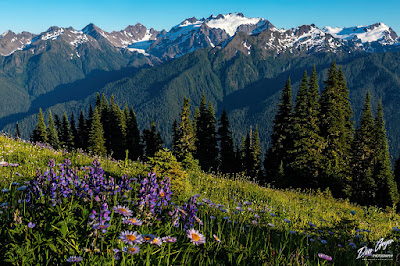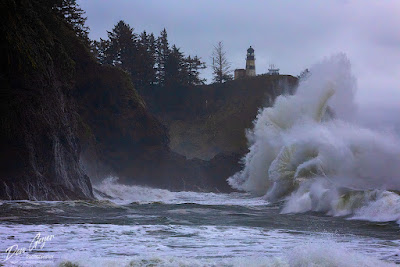 |
| The Quinault River from Pony Bridge. |
As you might know, Enchanted Valley is one of the most
popular destinations in Olympic National Park, which I’ve always found
interesting. Not because it isn’t a
worthwhile trip, but why it is. I
don’t find it overly scenic quite honestly (except Pony Bridge early on the
trek), especially late in season. The
valley is wide and vegetation is predominantly grass and brush due to its low
elevation, affording early season access (even year-around some years). If you like sub-alpine meadows, you won’t find
them here (but you will further up the valley in the summer months). Of course,
it also offers the wild Quinault River, which changes its course often and has
forced the relocation of the chalet. In
early season there are waterfalls cascading down the face of Chimney Rock and
the Burke Range high above. They’re
nice. They certainly bring character and
enjoyment to the valley in early season. However, I never found them very
photogenic as a stand-alone subject, even under desirable conditions (cloudy
and overcast). In my opinion, they make
a great backdrop to accompany other subject matter to help tell the story (example below).
What the area does offer (not solitude), is wildlife! Elk, bears, deer and more are extremely
common in this area and often make themselves available, especially in the
morning and evening. For me, this is the
highlight!
 |
| Black bear, Enchanted Valley. |
I first discovered this area in the mid-1990’s. I visited in mid-May, making sure to beat any
Memorial Weekend crowds. Backcountry
permits were self-issued at the Quinault Ranger station – no line. I shared the valley with one other
person. In two subsequent visits shortly
thereafter, I had it all to myself. I
doubt you will ever experience such solitude today. Now permits must be reserved in advance and
there is a quota which is often met.
The fond memories I have of that first visit was sitting
around camp and being surprised to see not one, not two, but three separate
bears appear across the meadows from me, grazing. I was nervous at first and wondered if I
would have to protect my tent and belongings (my food was hung), but soon
realized they didn’t care about my presence at all. I had never experienced such a thing.
 |
| Roosevelt Elk, Enchanted Valley. |
I stayed a couple of days exploring the area, but mostly just
watched the bears.
Then the day of departure arrived, and it was time to pack up
and move out. I was sad to leave, but
didn’t realize the biggest moment of my trip awaited me. As I wandered carefree down the trail past
Pyrites Creek lost in my thoughts, I came around a bend to find a sight I never
would have imagined – a bear a short distance off the trail sleeping on its
back with all four feet in the air! I
parked myself a safe distance away and watched it sleep and even listened to it
snore a couple of times! It eventually
opened an eye, saw me, and went back to sleep!
After a while it began getting restless and started rolling on either
side, whichever was more comfortable.
The nap became short and soon it decided it was time to wander up the
trail in the direction I had come, seemingly still somewhat groggy. I could not believe what I had just
experienced! This experience reaffirmed
that I would be back!
 |
Camp below the waterfalls of Enchanted
Valley. |
Of course, that experience never repeated itself.
Fast forward to 2023, when I returned once again in hopes of
seeing my “friends”. How different
things were. As mentioned above, permits
can be much more challenging to come by, and the crowds were ever-present from
beginning to end. There was no
solitude. Fortunately, however, my
“friends” were indeed there, seemingly waiting for me (hey, I can dream!).
So, for logistic planning, here is my take and input on this
trip:
It’s a long trek – 13.3 miles to Enchanted Valley. It’s very pleasant hike to take your mind
off the work, but typical of Olympic National Park trails, much up and
down. Many people consider breaking the
approach up into two days.
After crossing Graves Creek near the trailhead, the trail
follows an abandoned road for 2.4 miles, climbing over a ridge and then
descending steeply down to the crossing of the East Fork Quinault and Pony
Bridge. It’s a high bridge with the
river far below as its plunging waters negotiate a deep gorge. This is one of the most spectacular places
along this entire trail in my opinion, and you will want to spend some time to
enjoy! There is a camp on the far side
that I’ve always thought would be fun to enjoy.
 |
A sleeping black bear near the trail at Pyrites Creek.
|
From here the way continues mostly in forest, with many
creek crossings and ups and downs as it traverses terraces and moraine. There are a few trail washouts that must be
negotiated. Nothing too difficult
though. I call them speed bumps in the
trip!
There are camps all along the trail as you head up the
valley – typical of the Olympics. Many
you won’t find on a map.
 |
| Black bear in Enchanted Valley |
Pyrites Creek is reached at about 10 miles and is a nice
place to stay. Others obviously think so
too! It too has high wildlife traffic
and is within a short distance of visiting Enchanted Valley on a leisurely
visit, 3.5 miles further.
After crossing through a gate (yes, a gate), you are close
to the bridge crossing of the river and your arrival to Enchanted Valley. In case you are reading older guide books,
the suspension bridge is long gone, having been washed out. The current bridge requires a bit of
attention as it is simply a log that has been flattened on the top for walking
and has a single upstream handrail, high above the raging Quinault River. You would not want to fall here. After a long day of backpacking and tired
legs, this definitely gets your attention!
 |
| Black bear in Enchanted Valley |
Photography
Tips
Overcast days and even fog are the best days to visit this
area for photography. I find myself
using my 70-200mm lens the most by far here, often coupled with 2x
teleconverter for the wildlife. A
24-70mm lens is worth carrying if you plan to shoot landscapes. You might want to decide if the weight of a
wide-angle is worth carrying on this long of a trek. I would probably leave it at home if you are
not toting an RF lens.
 |
| Enchanted Valley Chalet, circa ~2002. |
Enchanted Valley is deep, so the harsh light comes quickly
in the morning and lasts all the way to sunset.
There is not much, if any transition.
This is not a location most people will be banking on “golden hour”
photography.
The season depends on your itinerary. Spring is great for wildlife as the snow up higher keeps them in the valley. Once the snow melts above, the animals see it as an invite to seek higher ground. It’s also the best time to enjoy the waterfalls, which all but dry up later in the year. If you wish to continue, the Anderson Pass area and LaCrosse Basin are fabulous places to visit beginning in mid-July most years.
 |
| Black bear in Enchanted Valley |
I hope you have found some of this information helpful in planning your own trip. The adventure can be as long as you want it to be! I would definitely budget no less than 3-4 days for it - more if you intend to extend the trip further towards LaCrosse Basin or Anderson Pass.
If you wish to seem more images from this wonderful park, please visit my Olympic Gallery.
As always, thanks for looking. Hope to see you on the trail!


































